A Mobility Model for a 3D Non-Stationary Geometry Cluster-Based Channel Model for High Speed Trains in MIMO Wireless Channels
Abstract
1. Introduction
- 1.
- A 3D, mobile and non-stationary cluster-based GBSM with scatterers located around the moving MRS is proposed.
- 2.
- The HST’s mobility is described by the enhanced Gauss–Makorv mobility model incorporating acceleration.
- 3.
- The death–birth Markov model is used to model the cluster MPCs.
- 4.
- The channel statistics, i.e., the local space-time correlation function (ST-CF), the root-mean-square Doppler shift spread, and the quasi-stationary intervals, are derived.
- 5.
- The simulated results of the proposed model are compared with the measured results.
2. A Mobility Model for a 3D, Non-Stationary Cluster and Geometry-Based Channel Model
2.1. Enhanced Gauss–Markov Mobility Model
2.2. Cluster Process Evolution
2.3. The HST Time-Varying Distances
2.4. Method of Equal Volume and the Proposed Sum of the Sinusoidal Simulation Model
2.5. Cluster Delay Update
2.6. Cluster Power Update
3. The Statistical Properties of the Channel Models
3.1. Local Space-Time Correlation Function
3.2. Channel Time-Variant Transfer Function
3.3. The RMS Delay Spread
The Stationary Time Interval
4. Numerical Simulation and Results
5. Conclusions
Author Contributions
Funding
Conflicts of Interest
References
- Cheng, X.; Huang, Z.; Bai, L. Channel Nonstationarity and Consistency for Beyond 5G and 6G: A Survey. IEEE Commun. Surv. Tutorials 2022, 24, 1634–1669. [Google Scholar] [CrossRef]
- Cheng, N.; He, J.; Yin, Z.; Zhou, C.; Wu, H.; Lyu, F.; Zhou, H.; Shen, X. 6G service-oriented space-air-ground integrated network: A survey. Chin. J. Aeronaut. 2021, 35, 1–18. [Google Scholar] [CrossRef]
- Liu, Y.; Wang, C.-X.; Huang, J. Recent developments and future challenges in channel measurements and models for 5G and beyond high-speed train communication systems. IEEE Commun. Mag. 2019, 57, 50–56. [Google Scholar] [CrossRef]
- Ghazal, A.; Yuan, Y.; Wang, C.-X.; Zhang, Y.; Yao, Q.; Zhou, H.; Duan, W. A non-stationary IMT-advanced MIMO channel model for high-mobility wireless communication systems. IEEE Trans. Wirel. Commun. 2016, 16, 2057–2068. [Google Scholar] [CrossRef]
- Zhou, L.; Luan, F.; Zhou, S.; Molisch, A.F.; Tufvesson, F. Geometry-based stochastic channel model for high-speed railway communications. IEEE Trans. Veh. Technol. 2019, 68, 4353–4366. [Google Scholar] [CrossRef]
- Ghazal, A.; Wang, C.-X.; Haas, H.; Beach, M.; Mesleh, R.; Yuan, D.; Ge, X.; Chahine, M.K. A non-stationary geometry-based stochastic model for MIMO high-speed train channels. In Proceedings of the 2012 12th International Conference on ITS Telecommunications, Taipei, Taiwan, 5–8 November 2012; IEEE: Piscataway, NJ, USA, 2012. [Google Scholar]
- Ghazal, A.; Wang, C.X.; Ai, B.; Yuan, D.; Haas, H. A nonstationary wideband MIMO channel model for high-mobility intelligent transportation systems. IEEE Trans. Intell. Transp. Syst. 2014, 16, 885–897. [Google Scholar] [CrossRef]
- Liu, Y.; Wang, C.-X.; Lopez, C.; Ge, X. 3D non-stationary wideband circular tunnel channel models for high-speed train wireless communication systems. Sci. China Inf. Sci. 2017, 60, 082304. [Google Scholar] [CrossRef]
- Assiimwe, E.; Marye, Y.W. A Stochastic Confocal Elliptic-Cylinder Channel Model for 3D MIMO in Millimeter-Wave High-Speed Train Communication System. Electronics 2022, 11, 1948. [Google Scholar] [CrossRef]
- Liao, C.; Xu, K.; Xie, W.; Xia, X. 3-D massive MIMO channel model for high-speed railway wireless communication. Radio Sci. 2020, 55, 1–19. [Google Scholar] [CrossRef]
- Assiimwe, E.; Marye, Y.W. A 3D MIMO Channel Model for a High-Speed Train Millimeter Wave Communication System under Cutting and Viaduct Environments. Electronics 2022, 11, 2025. [Google Scholar] [CrossRef]
- Bian, J.; Wang, C.X.; Gao, X.; You, X.; Zhang, M. A general 3D non-stationary wireless channel model for 5G and beyond. IEEE Trans. Wirel. Commun. 2021, 20, 3211–3224. [Google Scholar] [CrossRef]
- Imoize, A.L.; Ibhaze, A.E.; Atayero, A.A.; Kavitha, K.V.N. Standard propagation channel models for MIMO communication systems. Wirel. Commun. Mob. Comput. 2021, 2021, 8838792. [Google Scholar] [CrossRef]
- Liu, Y.; Wang, C.X.; Huang, J.; Sun, J.; Zhang, W. Novel 3-D nonstationary mmWave massive MIMO channel models for 5G high-speed train wireless communications. IEEE Trans. Veh. Technol. 2018, 68, 2077–2086. [Google Scholar] [CrossRef]
- Lai, F.; Wang, C.X.; Huang, J.; Gao, X.; Zheng, F.C. A Novel Beam Domain Channel Model for B5G Massive MIMO Wireless Communication Systems. IEEE Trans. Veh. Technol. 2022, 33, 329. [Google Scholar] [CrossRef]
- Huang, Z.; Cheng, X.; Yin, X. A General 3D Non-Stationary 6G Channel Model With Time-Space Consistency. IEEE Trans. Commun. 2022, 70, 3436–3450. [Google Scholar] [CrossRef]
- Wu, S.; Wang, C.-X.; Aggoune, E.-H.M.; Alwakeel, M.M.; You, X.-H. A general 3-D non-stationary 5G wireless channel model. IEEE Trans. Commun. 2017, 66, 3065–3078. [Google Scholar] [CrossRef]
- Kyösti, P.; Meinilä, J.; Hentilä, L.; Zhao, X.; Jämsä, T.; Schneider, C.; Narandzić, M.; Milojević, M.; Hong, A.; Ylitalo, J.; et al. WINNER II Channel Models; IST-4-027756; WINNER II D1.1.2, WINNER II Channel Models. D1. 1.2 V1. 2. IST-4-027756 WINNER II. v1.2. Available online: http://www.ist-winner.org (accessed on 19 April 2008).
- R M.2135-1; Guidelines for Evaluation of Radio Interface Technologies for IMT-Advanced; Report ITU: Geneva, Switzerland, 2009.
- Trindade, S.; da Fonseca, N.L.S. Channel Modeling and Characteristics for 6G Wireless Communications. IEEE Netw. 2021, 35, 326. [Google Scholar] [CrossRef]
- Li, J.; Niu, Y.; Wu, H.; Ai, B.; Chen, S.; Feng, Z.; Zhong, Z.; Wang, N. Mobility Support for Millimeter Wave Communications: Opportunities and Challenges. IEEE Commun. Surv. Tutor. 2022, 24, 1816–1842. [Google Scholar] [CrossRef]
- Feng, L. A stochastic confocal ellipsoid channel model for high speed railway MIMO communication systems. Phys. Commun. 2022, 52, 101616. [Google Scholar] [CrossRef]
- Zhang, Y.; Liu, Y.; Sun, J.; Wang, C.X.; Ge, X. Impact of different parameters on channel characteristics in a high-speed train ray tracing tunnel channel model. In Proceedings of the 2017 IEEE 85th Vehicular Technology Conference (VTC Spring), Sydney, NSW, Australia, 4–7 June 2017; IEEE: Piscataway, NJ, USA, 2017. [Google Scholar]
- Rasheed, I.; Hu, F.; Hong, Y.K.; Balasubramanian, B. Intelligent vehicle network routing with adaptive 3D beam alignment for mmWave 5G-based V2X communications. IEEE Trans. Intell. Transp. Syst. 2020, 22, 2706–2718. [Google Scholar] [CrossRef]
- Li, Y.; Wang, W.; Gao, H.; Wu, Y.; Su, M.; Wang, J.; Liu, Y. Air-to-ground 3D channel modeling for UAV based on gauss-markov mobile model. AEU-Int. J. Electron. Commun. 2020, 114, 152995. [Google Scholar] [CrossRef]
- Biomo, J.-D.M.M.; Kunz, T.; St-Hilaire, M. An enhanced gauss-Markov mobility model for simulations of unmanned aerial ad hoc networks. In Proceedings of the 2014 7th IFIP Wireless and Mobile Networking Conference (WMNC), Vilamoura, Portugal, 20–22 May 2014; pp. 1–8. [Google Scholar]
- Gutierrez-Diaz-de-Leon, C.A.; Patzold, M. Sum-of-sinusoids-based simulation of flat-fading wireless propagation channels under non-isotropic scattering conditions. In Proceedings of the IEEE GLOBECOM 2007—IEEE Global Telecommunications Conference, Washington, DC, USA, 26–30 November 2007; pp. 3842–3846. [Google Scholar]
- Gutierrez, R.M.; Yu, H.; Rong, Y.; Bliss, D.W. Time and frequency dispersion characteristics of the UAS wireless channel in residential and mountainous desert terrains. In Proceedings of the 2017 14th IEEE Annual Consumer Communications & Networking Conference (CCNC), Las Vegas, NV, USA, 8–11 January 2017; pp. 516–521. [Google Scholar]
- Yuan, Y.; Wang, C.X.; Cheng, X.; Ai, B.; Laurenson, D.I. Novel 3D geometry-based stochastic models for non-isotropic MIMO vehicleto-vehicle channels. IEEE Trans. Wireless Commun. 2014, 13, 298–309. [Google Scholar] [CrossRef]
- Zwick, T.; Fischer, C.; Didascalou, D.; Wiesbeck, W. A stochastic spatial channel model based on wave-propagation modeling. IEEE J. Sel. Areas Commun. 2000, 18, 6–15. [Google Scholar] [CrossRef]
- Bian, J.; Sun, J.; Wang, C.X.; Feng, R.; Huang, J.; Yang, Y.; Zhang, M. A WINNER+ based 3-D non-stationary wideband MIMO channel model. IEEE Trans. Wireless Commun. 2018, 17, 1755–1767. [Google Scholar] [CrossRef]
- Chang, H.; Bian, J.; Wang, C.X.; Bai, Z.; Zhou, W. A 3D non-stationary wideband GBSM for low-altitude UAV-to-ground V2V MIMO channels. IEEE Access 2019, 7, 70719–70732. [Google Scholar] [CrossRef]
- Paetzold, M.; Gutierrez, C.A. Definition and analysis of quasistationary intervals of mobile radio channels-invited paper. In Proceedings of the 2018 IEEE 87th Vehicular Technology Conference (VTC Spring), Porto, Portugal, 3–6 June 2018; pp. 1–6. [Google Scholar]
- Baum, D.S.; Kyösti, P.; Meinilä, J.; Jämsä, T. Final report on link level and system level channel models. In Proceedings of the Wirless World Research Forum Meeting 15, Paris, France, 1–3 December 2005. [Google Scholar]
- Zhang, J. IMT-2020 Channel Model. In Wiley 5G Ref: The Essential 5G Reference Online; Wiley: Hoboken, NJ, USA, 2019; pp. 1–18. [Google Scholar]
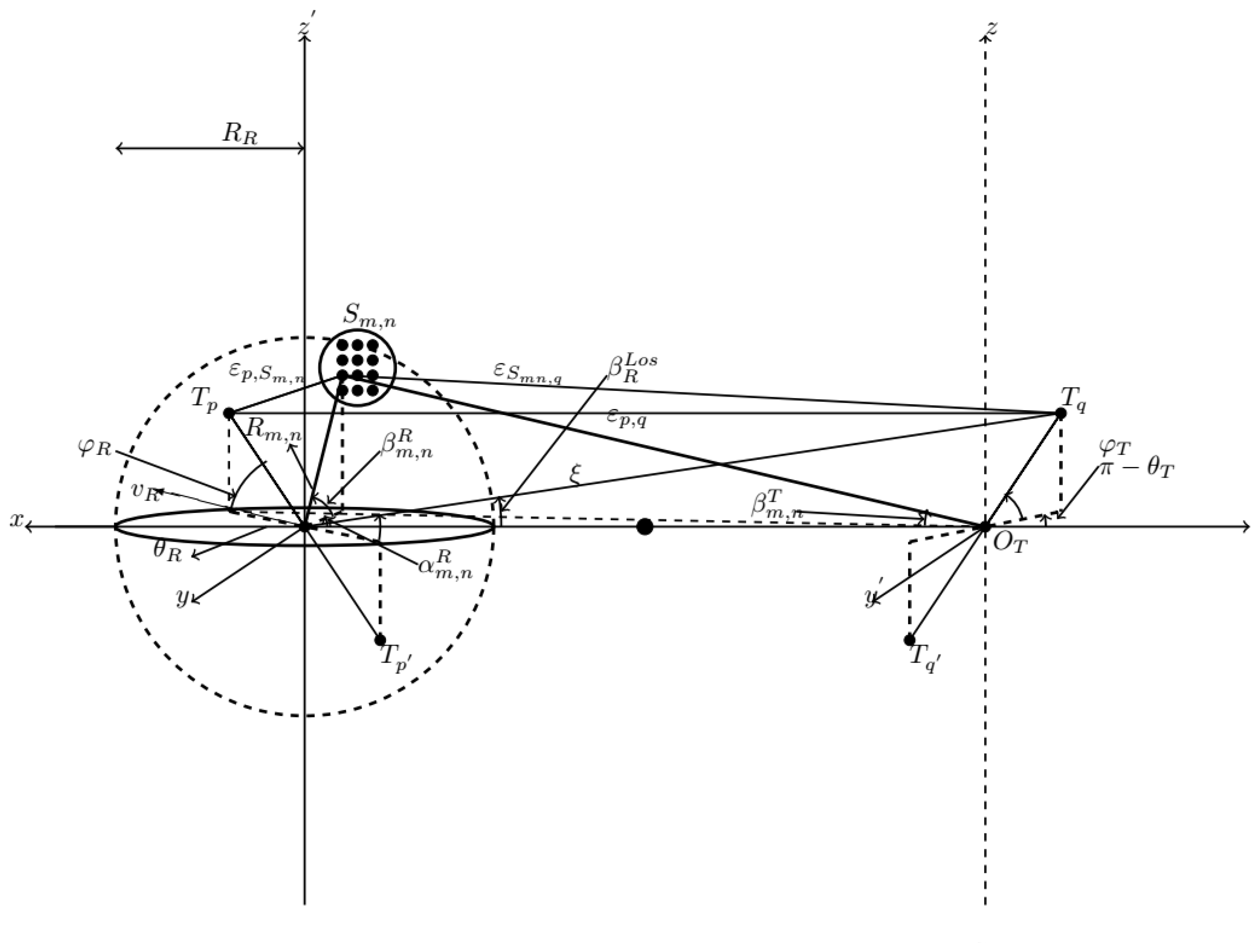
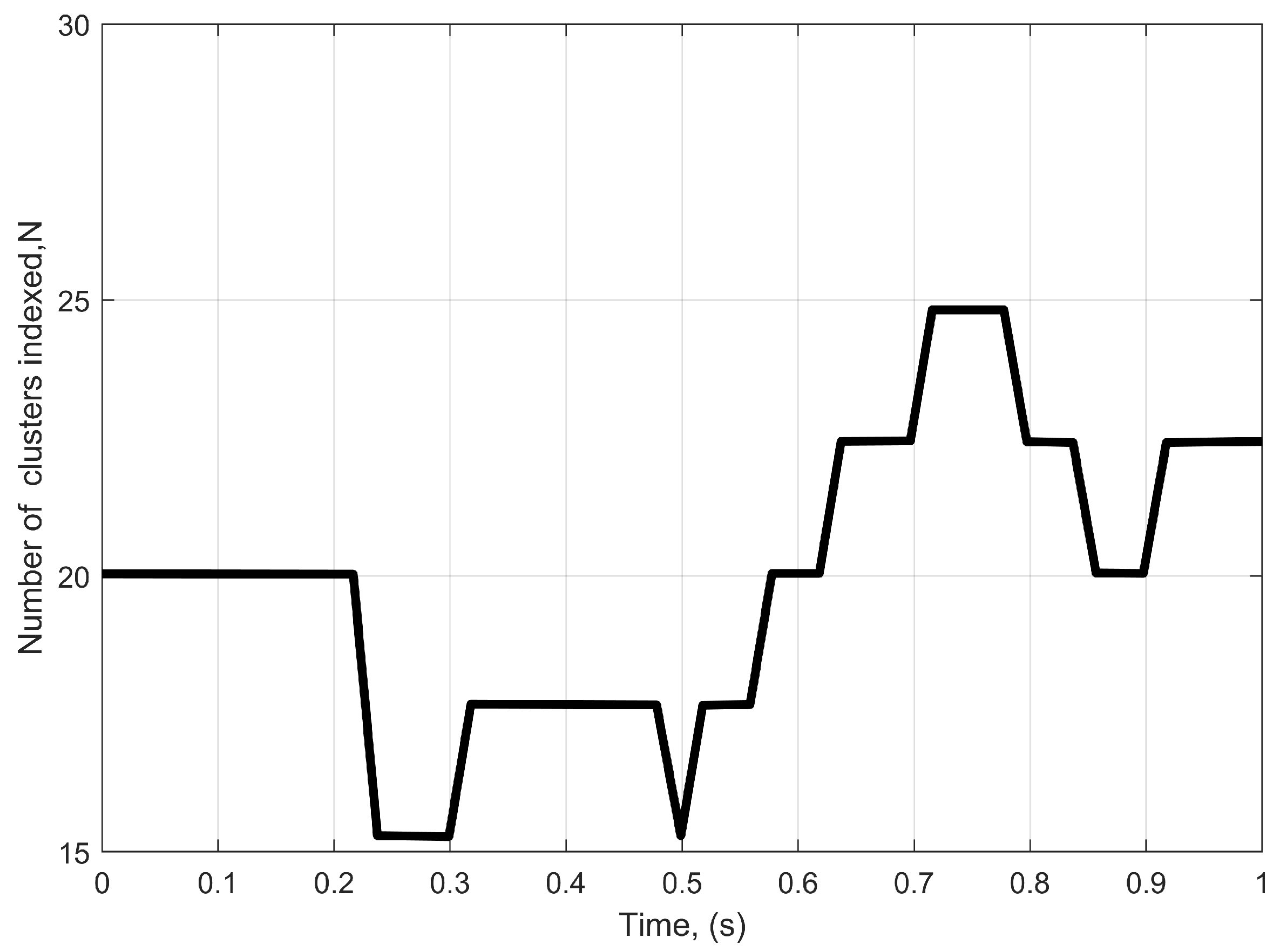
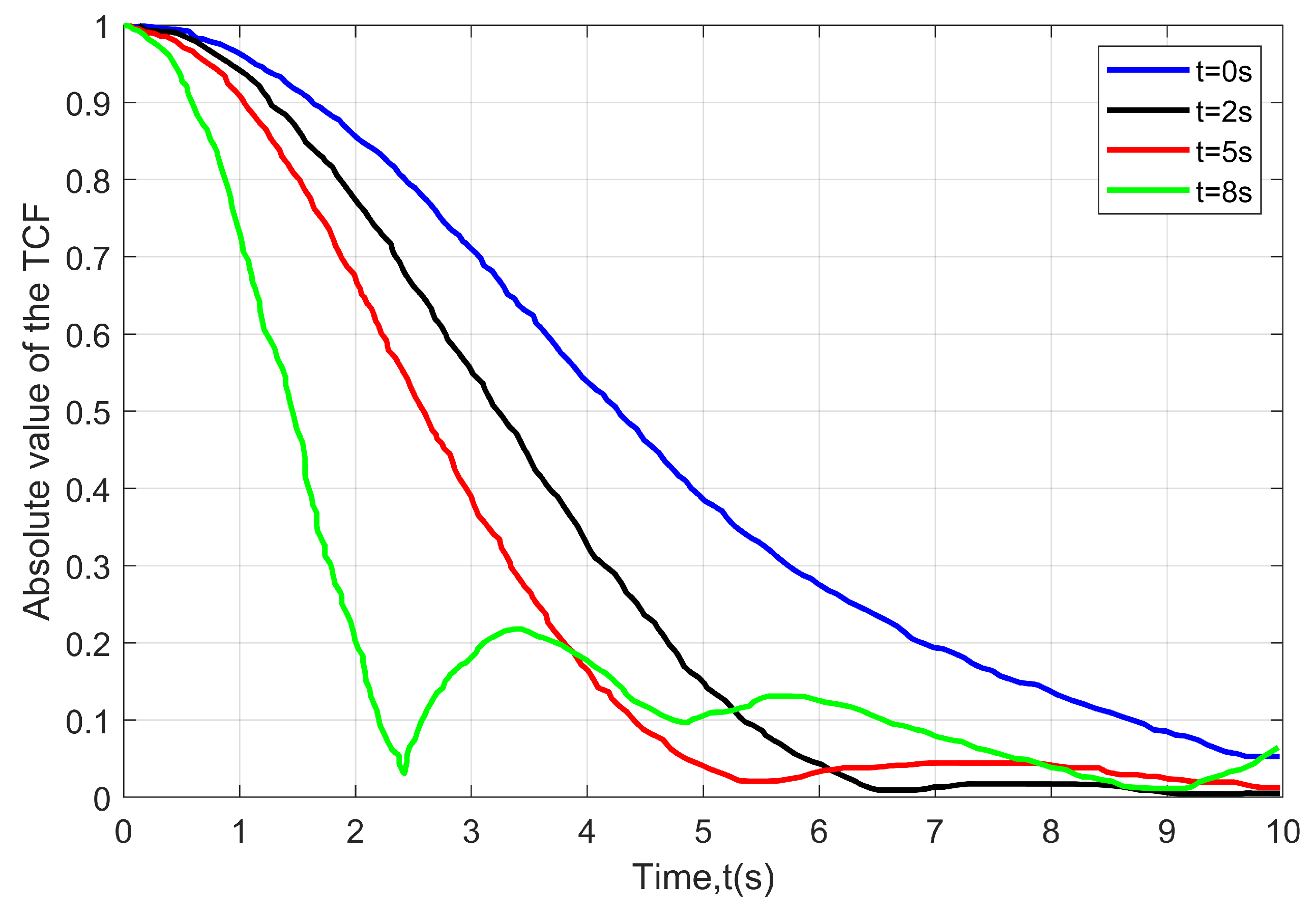

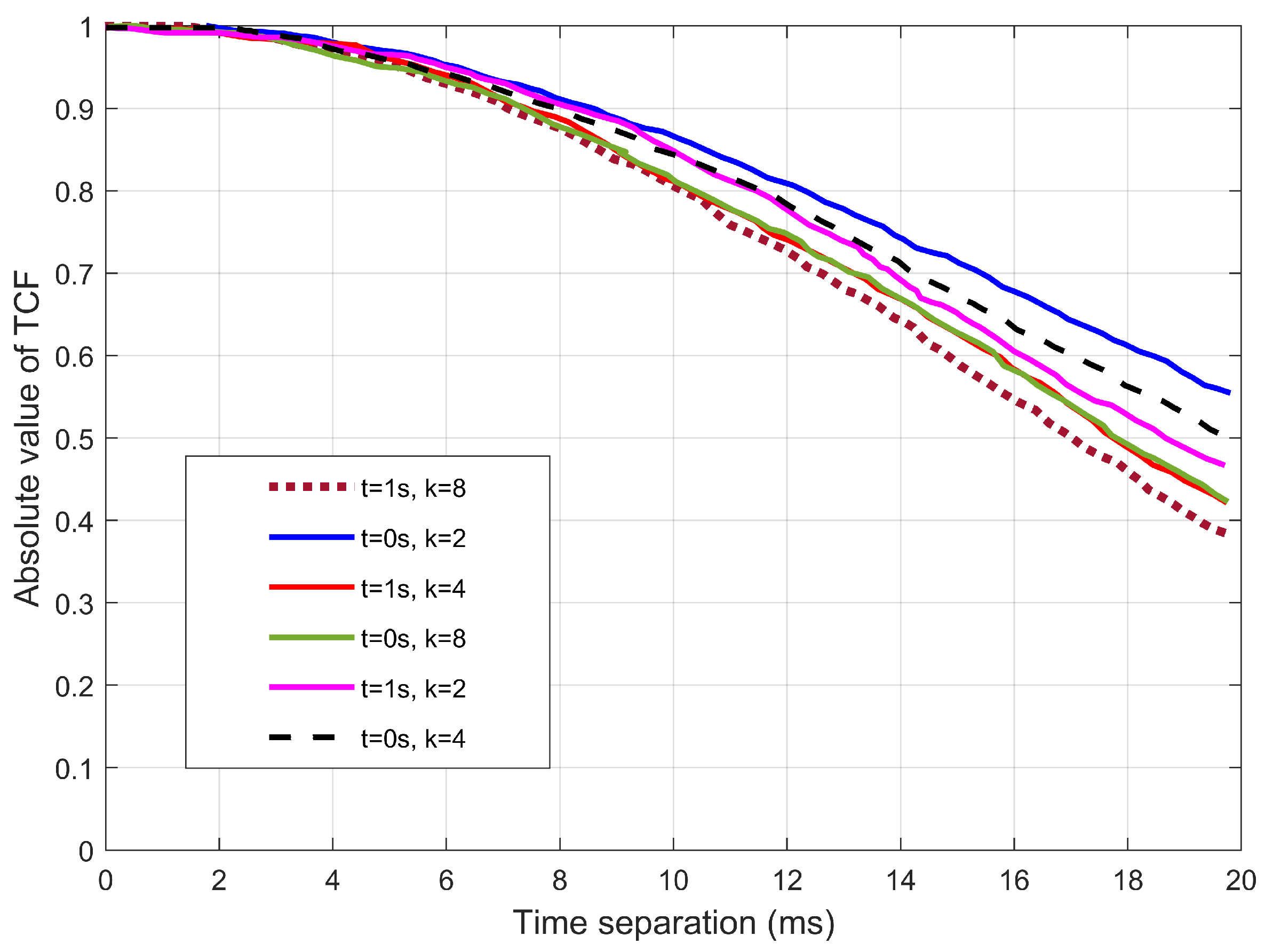

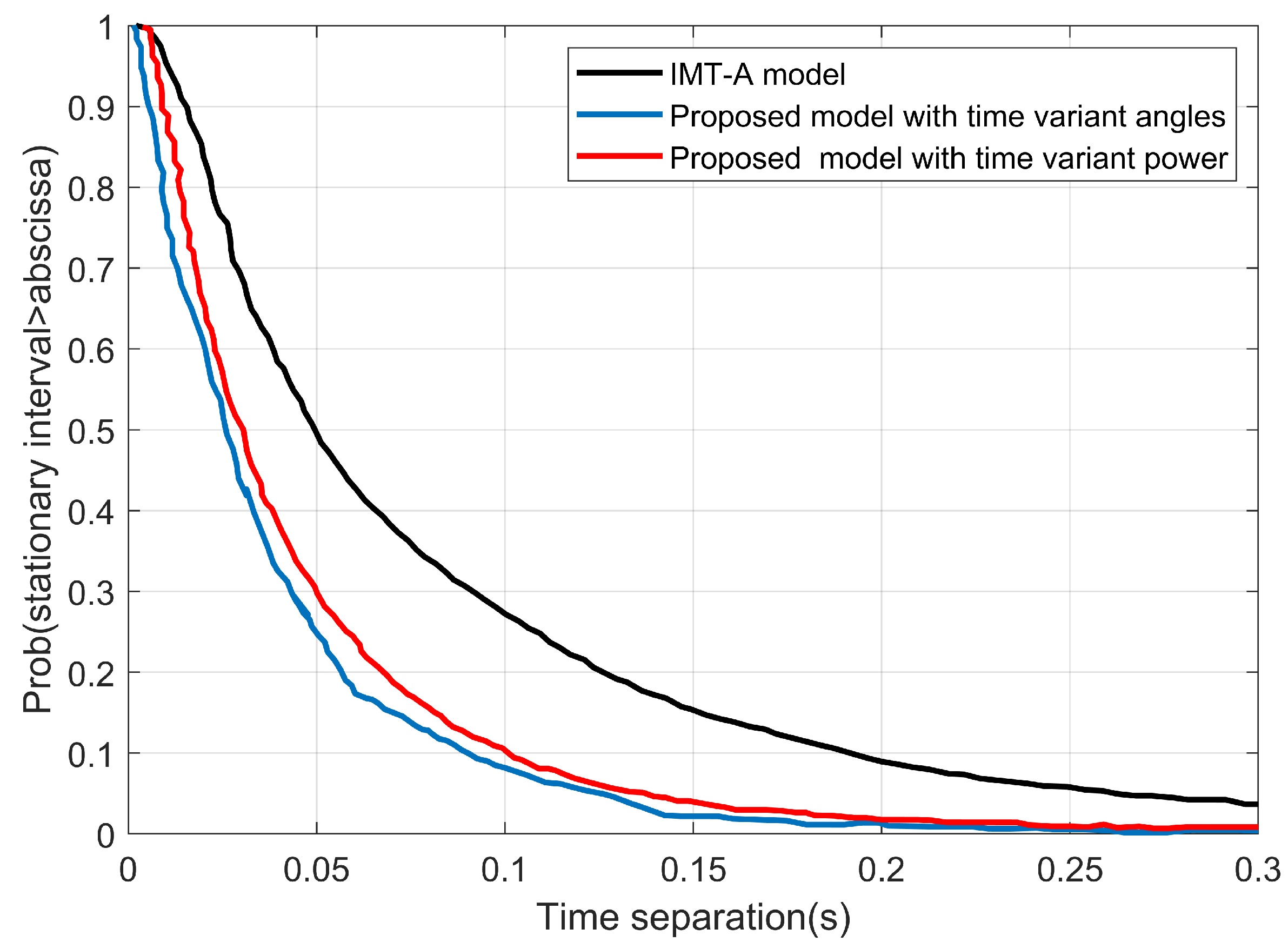
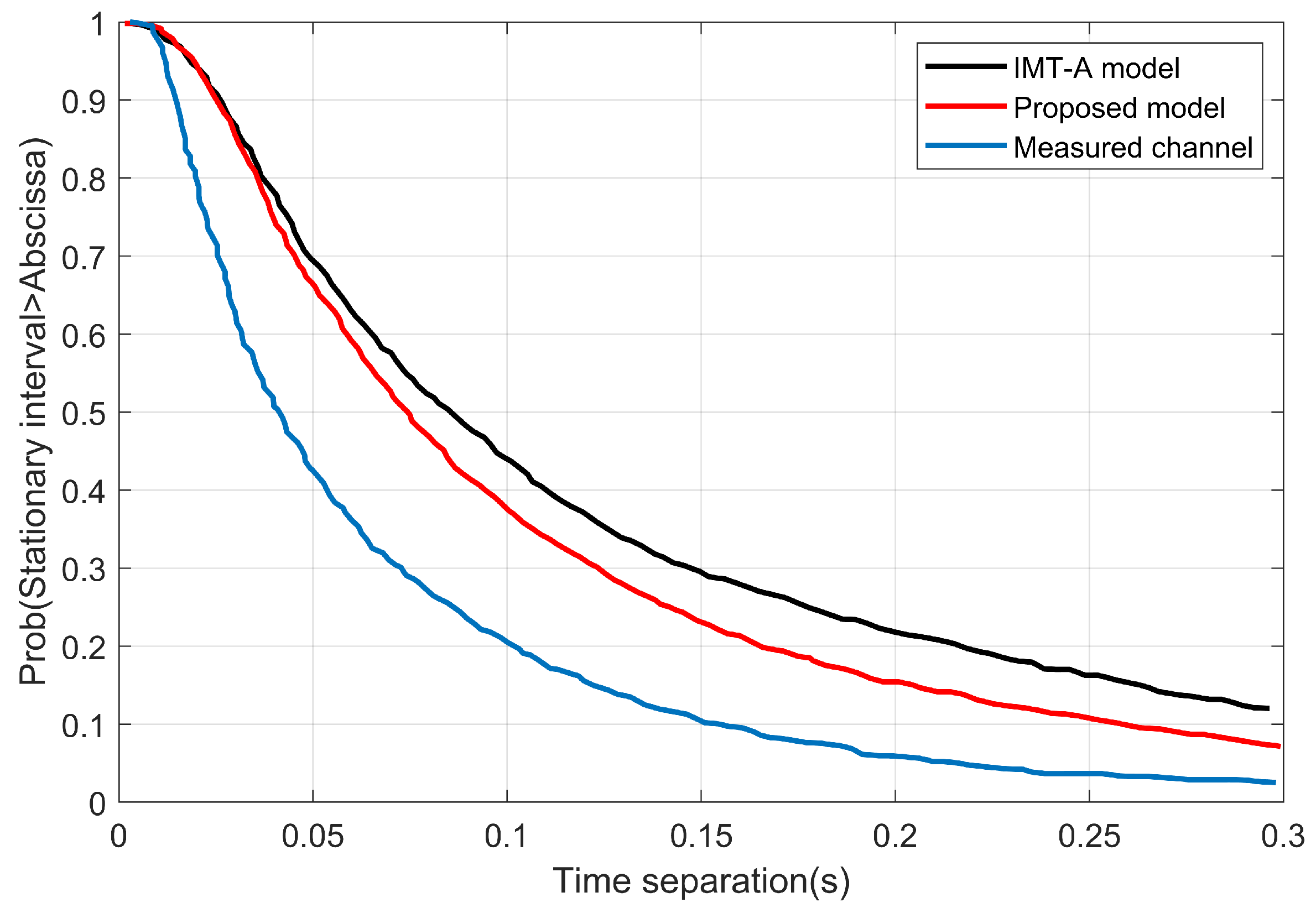
| Parameter | Definition |
|---|---|
| The horizontal distance between the center of the MRS and BS at initial time | |
| radius of the sphere around MRS | |
| half spacing between the two foci of the ellipse | |
| , | antenna spacing at the MRS and BS |
| , | orientation of the MRS and BS antenna array in the plane, respectively |
| , | angles of elevation of the MRS and BS antenna array relative to the plane, respectively |
| MRS velocity | |
| motion direction of the MRS | |
| , | AAoA and EAoA of the Los path, respectively, |
| The scatterer in the cluster | |
| AAoA of the wave traveling from effective scatterers of the cluster | |
| AAoD of the wave that impinges from effective scatterers of the cluster | |
| EAoA of the wave traveling from effective scatterers of the cluster | |
| EAoD of the wave that impinges from effective scatterers of the cluster | |
| Horizontal and elevation moving direction of scatterers, respectively | |
| Ricean K factors | |
| Velocity of moving scatterers |
| Parameter | Numerical Value |
|---|---|
| 20 | |
| 4 m/s | |
| 0.9 | |
| 0.01 | |
| 250 km/h | |
| 0.5 m/s | |
| 50 m | |
| 50 m | |
| 30 cm | |
| 3.8 cm | |
| 2.6 GHz | |
| 1000 m | |
| , | /2 |
| 0.8/m | |
| 0.04/m | |
| 0.3 | |
| K | 3.8 |
| 2 |
| Scenarios | Acceleration | Quasi Stationary Time |
|---|---|---|
| 1 | 0.6 m/ss | 0.21 s |
| 2 | 0.3 m/ss | 0.3 s |
| 3 | 0.2 m/ss | 0.451 s |
Publisher’s Note: MDPI stays neutral with regard to jurisdictional claims in published maps and institutional affiliations. |
© 2022 by the authors. Licensee MDPI, Basel, Switzerland. This article is an open access article distributed under the terms and conditions of the Creative Commons Attribution (CC BY) license (https://creativecommons.org/licenses/by/4.0/).
Share and Cite
Assiimwe, E.; Marye, Y.W. A Mobility Model for a 3D Non-Stationary Geometry Cluster-Based Channel Model for High Speed Trains in MIMO Wireless Channels. Sensors 2022, 22, 10019. https://doi.org/10.3390/s222410019
Assiimwe E, Marye YW. A Mobility Model for a 3D Non-Stationary Geometry Cluster-Based Channel Model for High Speed Trains in MIMO Wireless Channels. Sensors. 2022; 22(24):10019. https://doi.org/10.3390/s222410019
Chicago/Turabian StyleAssiimwe, Eva, and Yihenew Wondie Marye. 2022. "A Mobility Model for a 3D Non-Stationary Geometry Cluster-Based Channel Model for High Speed Trains in MIMO Wireless Channels" Sensors 22, no. 24: 10019. https://doi.org/10.3390/s222410019
APA StyleAssiimwe, E., & Marye, Y. W. (2022). A Mobility Model for a 3D Non-Stationary Geometry Cluster-Based Channel Model for High Speed Trains in MIMO Wireless Channels. Sensors, 22(24), 10019. https://doi.org/10.3390/s222410019









